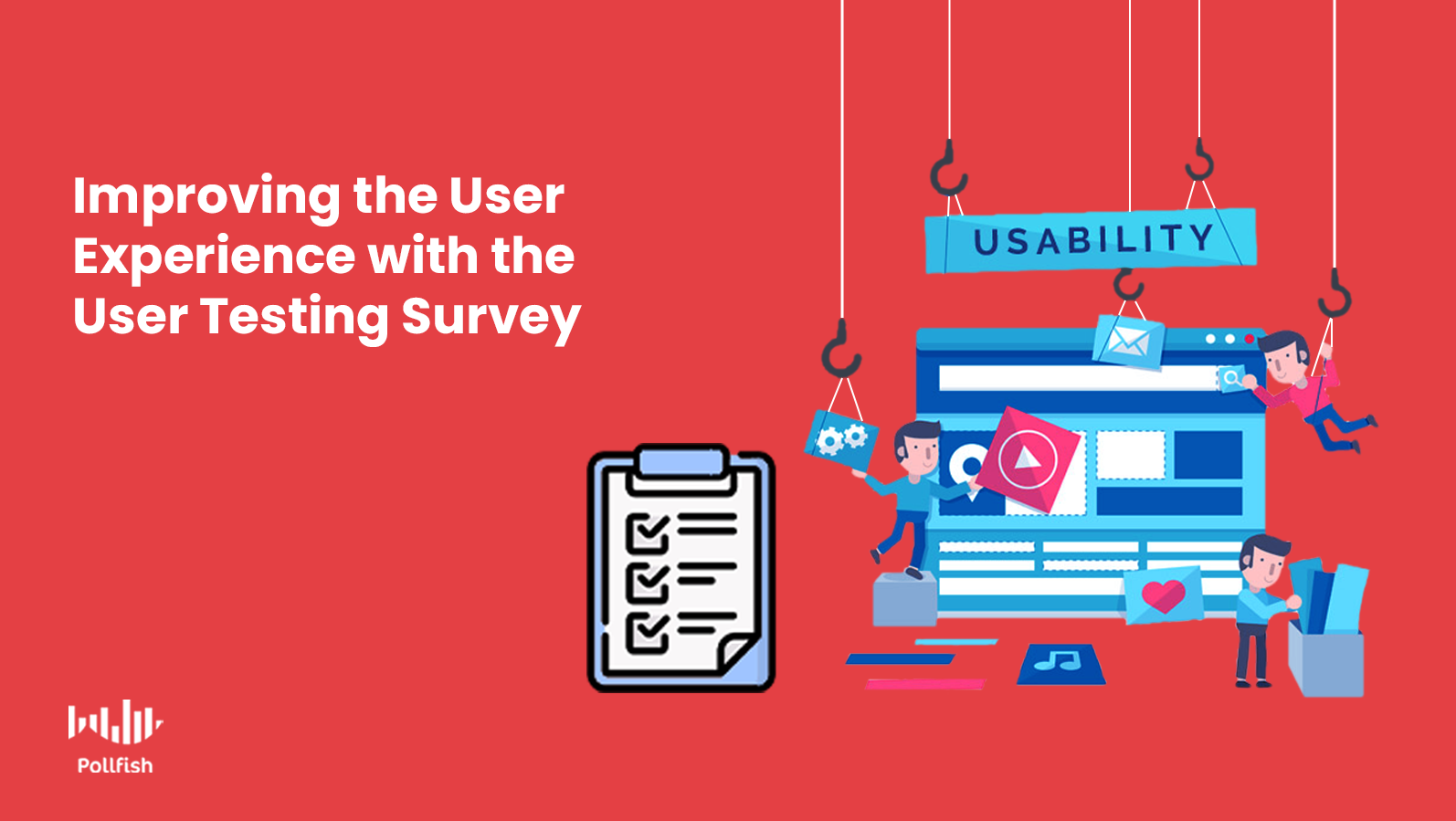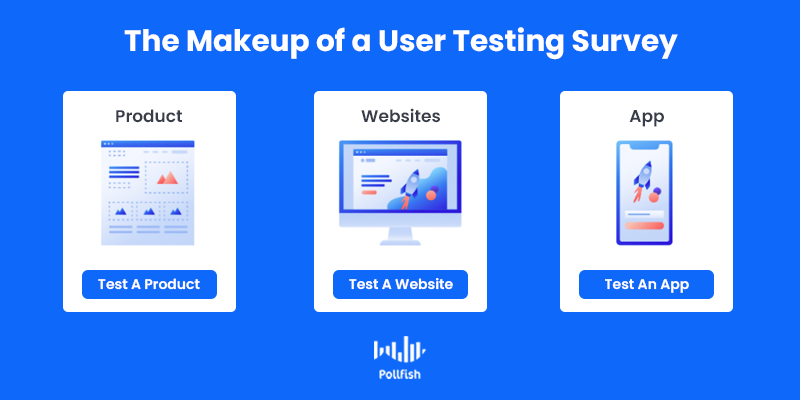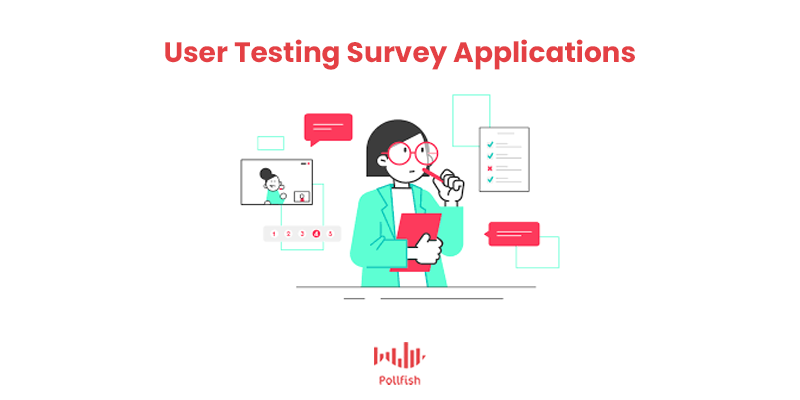Improve the Customer Experience with a User Testing Survey

Regardless of the size or vertical of your business, it can benefit from a user testing survey. This specific survey helps you capture how your customers use your product, engage with your online portals, assess their customer journeys and form their overall view on their customer experience (CX).
User testing is the gold standard for understanding how people interact with a product or interface in order to improve it. Unfortunately, the high cost associated with usability testing causes some business owners to forgo the process altogether.
While the insights provided through professional usability testing are invaluable, a user testing survey is an alternative for business owners who do not have the time or budget for traditional user testing. It’s also a good option for anyone who wants quick feedback at several key points in the product or interface development cycle.
This article explores how a user testing survey can yield critical information that helps your business boost the overall user experience
Defining the User Testing Survey
A user testing survey might be the right tool for you if you need to to learn exactly how people interact with your product, service, or a multitude of customer experience interfaces, but don’t have the time or budget to commit to the process of usability testing. Before we explore the nuts and bolts of a user testing survey, it’s important to have a basic understanding of usability testing.
User Testing Overview
Also known as usability testing, user testing is a method used to evaluate how people use and interact with a product or user interface. User testing gives business owners, product developers, along with all those on the digital team an opportunity to see their offerings in action to reveal their strengths and weaknesses.
Usability testing is most commonly used to test consumer products, websites or applications, and computer interfaces including the vast experiences and elements thereof.

During user testing, researchers will systematically observe how customers interact with a business’s vast array of offerings. or products. In most cases, user testing is performed with individuals who have never encountered or used the product before. This helps business owners quickly identify barriers that may impede product adoption.
While user testing has countless applications, it tends to share three main goals regardless of the user experience that is under evaluation. These are:
- Uncovering problems in the design of a user experience.
- Identifying ways to enhance the user experience of a product, service, online experience and all other customer experience (CX) types.
- Understanding how customers use the interface and how they feel while doing so
User testing is an involved process that typically involves planning, execution, and analysis phases, so many businesses rely upon a usability company to conduct user testing. Larger product development and computer or web development companies often have an internal usability department because user testing is integral to the success of their business.
Relying on a User Testing Survey
Given the expertise and time required to conduct user testing, hiring a usability company often comes with a steep price tag. As a result, budget-conscientious companies may avoid conducting user testing, which can be a costly mistake.
If your goal is to improve the user experience around your offering, but are constrained by a tight budget a user testing survey may provide an appropriate alternative to traditional user testing. In the usability survey process, a survey is distributed to customers who have used the product in order to gain insights about their experience.
The survey contains detailed, targeted questions about the user experience. In addition, brands can stand to include questions about the respondents’ feelings or opinions throughout their user experience.
While not ideal for diving deep into the issues that people encounter when using your product, user testing surveys can be used at certain key touchpoints when more general information is needed.
The Pros & Cons of a User Testing Survey
In comparison to traditional usability testing, a user testing survey offers some distinct benefits, but there are also some limitations associated with this tool. It’s important to have a clear understanding of the advantages and disadvantages before deciding to conduct a user testing survey.
The Advantages
- Cost-effective. You can develop and distribute a survey yourself, rather than hiring a usability company.
- Fast and easy to repeat. You can create a survey and distribute it within a day if needed. This makes it easy to quickly gather insights with each product iteration.
- Easy to collect feedback from a broad range of respondents. With traditional user testing, users are typically observed one at a time by the researchers. This naturally limits the number of users that can be observed within a given time period or budget.
- Gather large amounts of demographic data. By collecting demographic data at the outset of the survey, you can also gain a better idea about how demographics influence usability.
- Ability to compile both qualitative and quantitative answers. You can use a combination of open-ended and close-ended questions in order to obtain personalized and detailed responses, as well as those that can be quantified for easy analysis.
The Disadvantages
A user testing survey is not the perfect solution for every company or development iteration. Some limitations of a user testing survey include:
- Loss of direct observation. Traditional user testing lets you view exactly how your target audience uses your product. This enlightening and rewarding experience is not possible to replicate through a user testing survey.
- User recall may decrease the accuracy of the results. In traditional user testing, a researcher observes and talks to the participant in real-time. When you conduct a user testing survey, the participant is answering questions in retrospect. This may result in less accurate answers than you would get from direct observations.
- Insights may be broad, rather than specific. Sometimes, you will need to focus on very minute, specific interactions, which can only happen via direct observation.
The Applications of User Testing Surveys

User testing surveys can be used to gain deeper insights into many different types of products. Here are some examples of how user testing surveys can be used to:
- Understand user preferences for font style, size, or spacing on a website.
- Learn what emotions a new logo design invokes.
- Gather feedback about the level of frustration experienced with certain aspects of a shopping experience.
- Determine user preference for two distinct design styles in a website redesign process.
- Learn how users feel about their initial experience with a new phone.
- Test a new landing page to ensure it will convert well.
- Gauge the success of a new feature in a dashboard of a customer portal.
- Assess whether a new checkout flow is user-friendly.
- Determine if a chatbot provides an acceptable level of customer support.
- Understand how users access supplemental information about product sizing on a clothing website.
Remember that user testing is different from market research. It extends beyond simply gathering information about preferences, and seeks to identify barriers in the user experience.
Take It to the Next Level with a User Testing Survey
A user testing survey is a useful tool to quickly gather insights into the ease of use of a wide variety of your experiences. If you’re on a budget or under a tight deadline, a user testing survey may be the only way that you can gather vital information you need to make informed decisions about your product’s evolution.
In other cases, you may wish to utilize user testing surveys to complement a more in-depth usability testing process. By supplementing formal usability testing with surveys, you can gather insights from a larger group of users and use quantitative data to identify trends among user segments.
The applications of these surveys are endless and the cost to experiment with this form of usability testing is low. For this reason, user testing surveys are steadily gaining a foothold within businesses’ usability efforts.
Frequently asked questions
What is a user testing survey?
A user testing survey is a survey that helps you understand how your customers engage with your product and online portals as well as assess their customer journey and their perception of their customer experience (CX).
What is the user testing process?
The user testing process has three phases: planning, execution, and analysis. During this process, researchers observe how customers interact with a business’s offerings or products. In the usability survey process, surveys are distributed to customers who have used the product. The survey provides information on customer insights and their experience using the product.
What are the main goals of user testing?
User testing has three main goals: uncovering design problems, identity areas of improvement for user experience and customer experience and understanding how customers use the user interface and how they feel about it.
How much does user testing cost?
User testing cost depends on the online survey platform a researcher uses. Since you can develop and distribute surveys yourself, it is way more cost-effective than hiring a usability company. It’s also a faster option and can be easily repeated.
Is user testing the same as market research?
While it’s not the same as market research, it is a practice that market research can also gather. Specifically, it looks into how customers interact with the products or services a business offers. User testing is a specific type of market research that extends beyond gathering information about preferences to reveal issues with the user experience.
Pollfish Marketing Team
Ready to Try Pollfish?
Create your survey with AI, target high-quality respondents starting at $0.95 per complete, and start getting results in just minutes in real-time. From running a simple product concept survey to managing a constant stream of trackers for dozens of clients in dozens of countries, we’ve got you.
